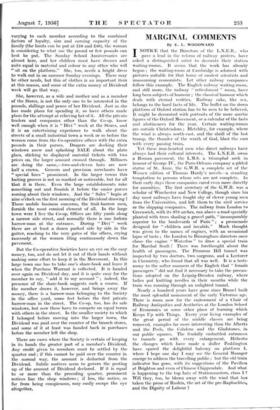MARGINAL COMMENTS
By E. L. WOODWARD
y NOTICE that the Directors of the L.N.E.R., who I gave a lead in the reform of railway posters, have asked a distinguished artist to decorate their station waiting-rooms. It seems that the work has already begun ; the waiting-room at Cambridge is adorned with pictures suitable for that home of modest scientists and unassuming economists. Let other railway companies follow this example. The English railway waiting-room, and still more, the railway " refreslunent " room, have long been subjects of humour ; the classical humour which deals with eternal verities. Railway cake, like sex, belongs to the hard facts of life. The buffet on the down platform of Oxford station has to be seen to be believed. It might be decorated with portraits of the more ascetic figures of the Oxford Movement, or a calendar of the fasts and abstinences for the year. Certain waiting-rooms are outside Christendom ; Bletchley, for example, where the wind is always north-east, and the shrill of the last trump, the thunder of the wrath of God, blast the cars with every passing train.
Yet these iron-hearted men who direct railways have always had their cultural interests. The L.N.E.R. owns a Roman pavement, the L.M.S. a triumphal arch in honour of George IV., the Paris-Orleans company a gilded statue of St. Anne, the G.W.R. a complete set of the Wessex edition of Thomas Hardy's novels—a standing temptation to persons whose sets are not complete. In their early days these companies cared even more directly for amenities. The first secretary of the G.W.R. was a scholar of Winchester and New College, though since his day most railways have fought shy of clever young men from the Universities, and left them to the civil service or the shipping companies. The railway from London to Greenwich, with its 878 arches, ran above a road specially planted with trees shading a gravel path, " incomparably superior to the boulevards of Paris " ; a promenade designed for " children and invalids." Much thought was given to the names of engines, with an occasional lapse of taste ; the London to Birmingham directors once chose the engine " Waterloo " to draw a special train for Marshal Soult ! There was forethought about the health of passengers. The Primrose Hill tunnel was inspected by two doctors, two surgeons, and a Lecturer in Chemistry, who found that all was well. It is a testi- mony to the softer manners of the English that " female passengers " did not find it necessary to take the precau- tions adopted on the Leipzig-Dresden railway, where ladies put knitting needles in their mouths while the train was running through an unlighted tunnel.
Nearly a hundred years have gone since Brunel built the most splendid monument of the early Victorian age. There is room now for the endowment of a Chair of Railway Antiquities and Aesthetics at the London School of Economics or some other place of learning which Keeps Up with Things. Every year living examples of the great period of the middle classes are being removed, examples far more interesting than the Alberts and the Peels, the Cobdens and the Gladstones, in our public squares. The feudally embattled entrances to tunnels go with every enlargement. Hitherto the changes which have made a duller Paddington have spared the delightful balcony on platform I, where I hope one day I may see the General Manager emerge to address the travelling public ; but the old train indicator has gone, with its suggestions of the Pavilion at Brighton and even of Chinese Chippendale. And what is happening to the top hats of Stationmasters, class I ? Will they, too, be blown away with the wind that has taken the prose of Ruskin, the art of the pre-Raphaelites, and the Dignity of Labour ?






































 Previous page
Previous page